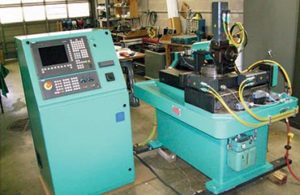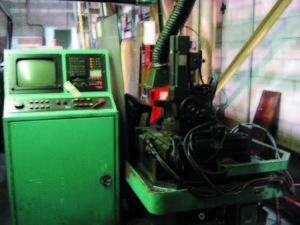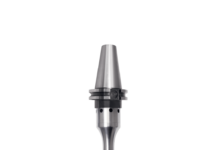SIEMENS RETROFIT BUSINESS DEVELOPMENT MANAGER SEES OPPORTUNITIES
Tom Curfiss details the rapidly evolving business climate for retrofit; impacting large production department, job shop machine tool sectors alike
Various market factors and economic conditions have made retrofitting existing machine tools a very viable option for the large metalworking department at an OEM, as well as the job shop sector of moldmakers, tool & die and contract part manufacturers alike, according to Tom Curfiss, the retrofit business development manager for Siemens.
 Speaking from his Cincinnati area office, Curfiss comments, “Today’s business climate has combined with economic factors involved in the manufacture of control packages to create an ideal atmosphere for retrofit. Our company has long been involved in the upgrade of large gantry mills for aerospace production, for example. But today, it’s just as likely you’ll find our Retrofit Solution Partners outfitting a 3-axis mill or even a basic lathe with a new entry-level or mid-range CNC, motor and drive package. And, the best news for the job shop, this work can now be done at a price point comparable to just the cost of the CNC a decade ago, owing to economies of scale in the manufacture of these control packages.”
Speaking from his Cincinnati area office, Curfiss comments, “Today’s business climate has combined with economic factors involved in the manufacture of control packages to create an ideal atmosphere for retrofit. Our company has long been involved in the upgrade of large gantry mills for aerospace production, for example. But today, it’s just as likely you’ll find our Retrofit Solution Partners outfitting a 3-axis mill or even a basic lathe with a new entry-level or mid-range CNC, motor and drive package. And, the best news for the job shop, this work can now be done at a price point comparable to just the cost of the CNC a decade ago, owing to economies of scale in the manufacture of these control packages.”
Siemens currently has 17 Retrofit Solution Partners under contract in the U.S. These companies work in close cooperation with Siemens to fully understand the possibilities of retrofitting machines with SINUMERIK CNC and to provide complete services for the installation and refurbishment of the CNC machine.
These partner firms for the Machine Tool Systems business at Siemens must have a demonstrated ability to work on CNC, PLC, servo motor, digital drive and all accompanying peripheral products, plus have a proficiency in the development of software packages related to PLC and CNC applications. Every Solution Partner then commits to a battery of training sessions on SINUMERIK controls and is required to keep at least two Siemens-trained engineers on staff at all times, according to Curfiss.
The Solution Partners are not geographic specific, as several have proven expertise in the field working on particular types or brands of machine tools. The selection process for the appropriate partner takes many factors into consideration, says Curfiss.
“We have partners who specialize in 5-axis machines, others who have expertise in a certain industry such as aerospace or medical, and still others who have their greatest  strength in a particular area of the country. Depending on the job specifics and the logistic costs involved, we work hard to match the right partner to the customer’s needs.”
strength in a particular area of the country. Depending on the job specifics and the logistic costs involved, we work hard to match the right partner to the customer’s needs.”
Typically, Curfiss continues, the tipping point on a retrofit job is 60% of the price of a new machine. However, he also points out that many machines have outdated controls, although they still perform adequately in the shop or production department.
“The challenge, when we do our onsite machine evaluation, is to determine whether a retrofit will make an appreciable difference in the performance of the machine, as other factors in the mechanics of the iron might make a retrofit impractical.”
Curfiss further noted that today’s control technology is evolving at a very rapid rate, making some equipment that went out of production just 10 years ago less than optimum in contributing to maximum machine tool performance. “Running machine tools with 20-year-old technology today will simply not keep a shop as competitive as it needs to be.”
Tom Curfiss has had his share of experiences with “old iron” in the field, as his background in machine tools spans over 40 years.
“A lot of people think their old iron is just impossible to keep running, even with a retrofit, but we’re able to make the old equipment run better than it did when it was new, quite often.” He notes this achievement is the result of faster control processors, improved motor and drive technology, even more accurate and responsive encoders and other machine status sensing devices. On a practical note, Curfiss also remarks, “You cannot, however, fix a broken leg with a bandage, so the machine evaluation needs to be very comprehensive.”
 In the end, Tom Curfiss suggests, both the large production departments and the job shops alike need to have regular assessments done on their prototype and production machine tools to determine if a retrofit might be in order. “The savings can be substantial, compared to purchasing new machines, because it’s not just a matter of the dollars saved at the outset, it’s also the long-term production improvements that inevitably lead to even greater profit for the job shop or OEM.”
In the end, Tom Curfiss suggests, both the large production departments and the job shops alike need to have regular assessments done on their prototype and production machine tools to determine if a retrofit might be in order. “The savings can be substantial, compared to purchasing new machines, because it’s not just a matter of the dollars saved at the outset, it’s also the long-term production improvements that inevitably lead to even greater profit for the job shop or OEM.”
For more information about Siemens CNC solutions for the machine tool industry, visit our website: www.usa.siemens.com/cnc. Join the user community by following us on Facebook: www.facebook.com/SiemensCNC and talking to us on Twitter: www.twitter.com/siemens_cnc_us.
For specific product information and inquiries, call (800) 879-8079 ext. Marketing Communications or send an e-mail to: SiemensMTBUMarCom.industry@siemens.com
Siemens Industry Sector is the world’s leading supplier of innovative and environmentally friendly products, solutions and services for industrial customers. With end-to-end automation technology and industrial software, solid vertical-market expertise, and technology-based services, the sector enhances its customers’ productivity, efficiency and flexibility. With a global workforce of more than 100,000 employees, the Industry Sector comprises the Industry Automation, Drive Technologies and Customer Services Divisions as well as the Metals Technologies Business Unit.
The Siemens Drive Technologies Division is the world’s leading supplier of products, systems, applications, solutions and services for the entire drive train, with electrical and mechanical components. Drive Technologies serves all vertical markets in the production and process industries as well as the infrastructure/energy segment. With its products and solutions, the division enables its customers to achieve productivity, energy efficiency and reliability.





















